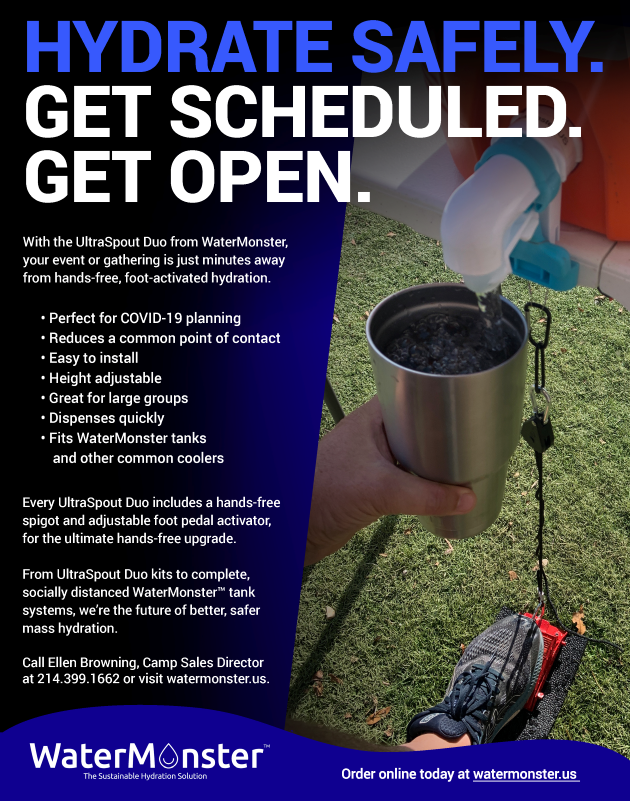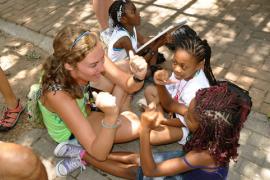So much of a camp director’s time is oriented toward risk reduction. From hiring lifeguards to teaching CPR, the number-one priority is “keeping kids safe,” followed by fun and learning in form or fashion.
But what if we’re going about this all wrong?
Healthy Risk-Taking
That is not to say that safety is a misplaced priority. It most definitely is not. Yet a true calculus of risk necessarily mandates balance. In other words, an understanding of bad risks and good, healthy risks. After all, summer camps are a perfect petri dish for encouraging young people to stretch their boundaries, try new things, and build new relationships. Indeed, campers often report feeling more comfortable testing their limits at camp than they ever would in school.
On this score, the children may be ahead of us.
Research from Students Against Destructive Decisions (SADD) revealed that while many, if not most, adults equate risk-taking with negative behaviors such as bullying, alcohol and other drug use, and early, intimate sexual behavior, the majority of young people view risk in a positive light. Because children, especially preteens and teens, are hardwired to take risks, it may be easier to steer them toward positive iterations of risk that bring with them incredible opportunities for personal, intellectual, and social growth.
Better yet, the data reveals that youth who take positive risks in their lives are significantly less likely to engage in behaviors that pose danger. These young people describe themselves as responsible, confident, successful, and optimistic. They also report that they often feel happy and are prone to considering potential negative outcomes of what may be thought of as traditional risk behaviors. Finally, positive-risk seekers are less likely than their peers to report frequently feeling bored or depressed.
What do these positive risks look like?
Among the most important are the physical, social, and emotional risks that the camp experience promotes. Young people who challenge themselves by engaging in physical or athletic events (e.g., rock climbing, swim meets); joining in social activities with other kids (e.g., dances, skits); or opening up and sharing their feelings about their own life experiences (e.g., being away from home, conflicts with a friend) may benefit the most.
Other examples of positive risk-taking include:
- Reaching out to make a new friend
- Trying a new activity
- Attempting to clear up a misunderstanding
- Volunteering to help others
- Mentoring younger children
The quantity of positive-risk activities appears not to be a reliable predictor of reward. It is the challenge in the behaviors themselves (i.e., those that pose the possibility of failure) that makes the difference.
In this sense, camps and camp counselors can play an active role in helping young people to build resilience (or lessen their fear of failure) by modeling a willingness to step outside of their comfort zone and manage setbacks.
Resiliency, Risk, and Mental Health
Raising resilient kids is all the rage and is correlated with overall mental health.
In their book Growing Up Resilient, authors Tatyana Barankin and Nazilla Khanlou counsel, “People who are resilient can effectively cope with, or adapt to, stress and challenging life situations. They learn from the experience of being able to effectively manage in one situation, making them better able to cope with stresses and challenges in future situations” (Barankin and Khanlou, 2007).
Resiliency theorist Bonnie Benard, MSW, says, “We are all born with innate resiliency, with the capacity to develop the traits commonly found in resilient survivors: social competence (responsiveness, cultural flexibility, empathy, caring, communication skills, and a sense of humor); problem-solving (planning, help-seeking, critical and creative thinking); autonomy (sense of identity, self-efficacy, self-awareness, task-mastery, and adaptive distancing from negative messages and conditions); and a sense of purpose and belief in a bright future (goal direction, educational aspirations, optimism, faith, and spiritual connectedness)” (Benard, 2018).
What’s the link between camp and resilience? In his Camping Magazine article “Camps Help Make Children Resilient,” Michael Ungar, PhD, wrote, “When it comes to resilience, nurture trumps nature. Camps, like good schools and loving families, immunize children against adversity by giving them manageable amounts of stress and the supports they need to learn how to cope effectively and in ways that are adaptive . . . .”
Ungar went on to enumerate seven states children need and can experience at camp (Ungar, 2012):
- New relationships, not just with peers, but with trusted adults other than their parents.
- A powerful identity that enables them to feel confident in front of others and provides them with something genuine to like about themselves.
- An atmosphere that helps children feel in control of their lives.
- An environment in which all children are treated fairly.
- A facility that gets children what they need to develop physically.
- A chance to feel like they belong.
- A better sense of their culture.
Failing Forward
The value of learning — and practicing — resilience at summer camp was encapsulated in a speech then-16-year-old Cameron Gray gave to younger campers in his role as teen leader at Connecticut’s Camp Hazen. He shared it with me in an email.
I want all of you to think of something you are good at, maybe a sport or a skill you learned at camp. Now, I want you to imagine how skilled you would be at that same activity if you have never failed while trying it. Probably pretty bad, right?
What is failure? Well, people define it as being unsuccessful or not being good enough. However, I see failure as being successful. One of my favorite sayings is “failing forward.” This means that in order to progress, you need to have setbacks.
I want to make it clear to all of you now that failure is OK and is needed to progress in life. When we were all younger, most if not all of our parents warned us to never touch the stove when it is on. What did you do next? You probably touched it but, guess what, now you know to never touch a hot stove again.
Let me take you way back to my freshman year. I was sitting in World History class waiting to get my test back. Thinking I did amazing, I asked my teacher what the worst score was. He said 57 percent. I ironically said to myself, “What idiot got 57 percent?” I got 57 percent. I was that idiot. In reality, this setback made me a much better student. This is just one example of how one minor setback has pushed me to success.
Now for you, it might be getting out in Gaga or slipping off the Alpine Tower just as you’re about to get to the top. No matter the type of failure, no matter the circumstance, learn from what went wrong and, eventually, you will realize your goals.
My point with all these examples is to make sure that all of you know that failing forward is necessary for personal growth.
I’m going to tell you another story. About two months ago, I was playing third base in a baseball game. The batter hit a hard ground ball to me, it took a bad hop, then BOOM. I’m looking at the sky with blood all over my face and hands. This experience was not particularly a failure but more of a learning experience that taught me to always keep my right hand up while taking ground balls.
However, a learning experience doesn’t always have to be getting hit in the face with a baseball. It can be as small as saying the wrong thing at the wrong time and having what you said ruin the relationship you had with that person.
News flash, failing forward is the way to go. No matter what happens or what grade you get or any setbacks you have, always know that leaders become great leaders from failure and mistakes.
We can add to Gray’s wisdom with some provided by Lizzy Francis for parents. She says parents of resilient kids do the following eight things (Francis, 2021). They:
- Let kids struggle.
- Let their kids experience rejection.
- Don’t condone a victim mentality.
- Do more than tell them to “buck up” when struggles occur.
- Help their kids learn how to label their feelings and emotions.
- Give their kids the tools to self-soothe.
- Admit their mistakes. And then they fix them.
- Always connect their kids’ self-worth to their level of effort.
Perhaps not surprisingly in this age of pandemic, resiliency has taken a blow. New data from the Center for Adolescent Research and Education (CARE) and Total Brain notes that high school and college students score well below the 50th percentile in self-control and, more specifically, resilience.
That makes the roles of summer camps all the more critical — and urgent.
Specifically, camp counselors can help children to take positive risks by:
- Modeling inclusive social behavior.
- Identifying and discussing emotional reactions to issues or events.
- Supporting group activity and/or athletic participation.
- Involving campers in community-service project(s).
- Supporting a wide sampling of interests, activities, and age-appropriate behaviors.
- Encouraging separation from parents and age-appropriate independence in decision-making.
- Teaching peer-to-peer social skills and facilitating (positive) peer relationships.
They can also gain some tips from a new book from Christopher Thurber, PhD, and Hendrie Weisinger, PhD, who say, “Upholding high standards, providing reliable warmth, setting a good example, offering encouragement, granting freedoms to take healthy risks, and coaxing lessons from mistakes are among the most powerful ways to promote positive youth development” (Thurber & Weisinger, 2021).
Changing Lives
It is clear that camp counselors make a positive difference in the lives of young people. Now we know more about why.
By promoting positive risk-taking, counselors can boost campers’ sense of self and cement in place important prevention factors that will help them to avoid trouble outside of camp. And laying an early and solid foundation of good decision-making helps young people to build productive, enriching, and successful lives.
In this way, the camp experience transcends time and place, unleashing on communities across the country and around the world the energy, optimism, and industriousness of youth.
Photo courtesy of Kamp Kohut, Oxford, ME.
Stephen Gray Wallace, MS Ed, is a doctoral candidate in educational leadership and innovation at St. Thomas University in Miami, Florida. He is also an associate research professor and president and director of the Center for Adolescent Research and Education (CARE). Stephen has broad experience as a camp director and school psychologist. He is a member of the professional development faculties at the American Academy of Family Physicians and American Camp Association and a parenting expert at kidsinthehouse.com, NBC News Learn, and WebMD. He is also an expert partner at the Risk Assistance Network & Exchange (RANE) and was national chairman and chief executive officer at SADD for 16 years. Stephen is an award-winning writer and author of the books Reality Gap and IMPACT. Additional information about Stephen’s work can be found at StephenGrayWallace.com.
(c) Summit Communications Management Corporation 2021. All Rights Reserved.
References
Barankin, T. and N. Khanlou. (2007). Growing Up Resilient: Ways to Build Resilience in Children and Youth. Toronto, Ontario, Canada: Centre for Addiction and Mental Health.
Benard, B. (2021). The foundations of the resiliency framework. Resiliency in Action. www.resiliency.com/free-articles-resources/the-foundations-of-the-resil… (21 Sept. 2021).
CARE. (2021). Center for Adolescent Research and Education. Ecareforkids.org (21 Sept. 2021).
Francis, L. (2018). Resilient kids from parents who do these 8 things. Fatherly. November 26, 2018. www.acacamps.org/resource-library/camping-magazine/camps-help-make-chil… (21 Sept. 2021).
SADD. (2005). Students against destructive decisions. SADD.org. (21 Sept. 2021).
Thurber, C. and H. Weisinger. (2021). The Unlikely Art of Parental Pressure. Boston, MA: Hachette Go.
Total Brain. (2021). High prevalence of mental health risk amid COVID pandemic taking a serious toll on U.S. students’ cognition. February 24, 2021. www.totalbrain.com/high-prevalence-of-mental-health-risk-amid-covid-pan… (21 Sept. 2021).
Ungar, M. (2012). Camps help make children resilient. Camping Magazine. September 2012. www.acacamps.org/resource-library/camping-magazine/camps-help-make-chil… (21 Sept. 2021).



